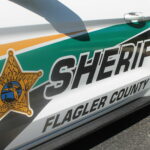It was happenstance that FireFlight ended up in northwest Flagler County on Saturday afternoon (June 8) – near the St. Johns border – and spotted a fire in the habited portion of Flagler Estates that had yet to be reported. Chief Pilot Neil Egerton, who was testing one the county’s 210-gallon Bambi Buckets (used to drop water), notified the neighboring county and stayed to help the St. Johns County Fire Department get the fire under control.”
“St. Johns (Fire Department) was unaware of the fire, and amazingly no residents had called it in,” Egerton said. “Three structures were in danger with fire right up to live animal pens.”
Egerton said the fire was tall and climbing. Flagler Estates is rural and situated in a heavily wooded area. He dropped 19 buckets – or 3,990 gallons of water – as well as eight gallons of fire-suppressing foam due to the severity of structure involvement.
“This could have turned out very badly if left unattended,” Egerton said.
Given its many functions – including patient transportation, search and rescue, and law enforcement assistance – people often ask why FireFlight was given its name. It was purchased in 2002 for $1.55 million with Landfill Bond money designated for fire suppression. No General Fund money was used.
It was purchased after the ‘98 wildfires, which was the first time in US history that an entire county was evacuated due to wildfire. During those fires 71 homes were destroyed, and another 175 homes were damaged.
About 82,000 acres of timber – that was valued at $4,000 per acre – burned. The timber loss alone was $328 million. Flagler County spent about $1.3 million in protective measures in 1998.
“Countless wildfires have been quashed with the help of FireFlight, which is a great asset to Flagler County,” said Fire Rescue Chief Michael Tucker. “More than 2.1 million gallons of water have been dropped on fires since 2002.”
Flagler County anticipates the delivery of FireFlight’s replacement – an Airbus Helicopters model H125 aircraft – within the third quarter of this fiscal year. The aircraft has a top speed of 150 mph, and a range of 430 miles. It is the first line of defense against wildfires that start in remote, difficult to reach areas of Flagler County as it can travel anywhere within the county in 15 minutes.
“The new aircraft is the newest version of the aircraft we have now with the latest technology and safety features including dual hydraulics, a crash resistant fuel tank, upgraded with a stronger engine package with redundant systems that provide an additional 75 shaft horsepower,” said Flight Operations Chief Todd Whaley. “These enhancements give the FireFlight pilots a higher power margin for safety and error when performing the complex and highly technical task of Bambi Bucket, wildland fire suppression operations.”










